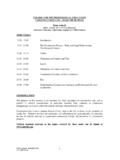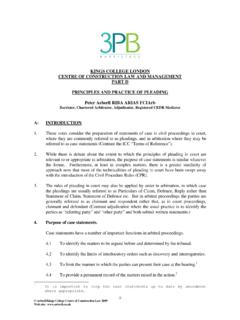Transcription of Peter D Aeberli Barrister - Arbitrator - Mediator ...
1 Peter D Aeberli Barrister - Arbitrator - Mediator Adjudicator SEMINAR FOR LAW SOUTH COLLATERAL WARRANTIES SESSION 1: CREATING LIABILITY FOR THIRD PARTY LOSSES Peter Aeberli RIBA, ARIAS, FCIArb, Barrister Chartered Arbitrator , Adjudicator, Registered CEDR Mediator PART A: THE THIRD PARTY LIABLITY PROBLEM 1. Practical issues In many construction projects those who suffer loss, purchasers, tenants, funders, if there are defects in design or construction do not have direct contractual links with those responsible for the design and construction. Furthermore, because of the doctrine of caveat emptor and the widespread use of full repairing leases, purchasers and tenants will have no recourse against the original developer, who does have direct contractual links with those responsible for the defects.
2 Even where there is a contractual chain of liability between the person suffering the loss and those responsible for that loss, it may be broken, for instance by intermediate insolvency. In such cases, the common law of contract and tort provides little assistance. 2. Contract issues (privity) Under the doctrine of privity of contract only a person who is a party to a contract, one who has given consideration for the other party s promises, can sue and be sued on that contract. Thus, subject to a limited number of exceptions, a contract cannot create enforceable rights for persons (third parties) who have not given consideration to the promisee.
3 Neither can a contract impose burdens on third parties. 3. Tort issues the duty of care problem in negligence Apart from where the third party has suffered physical injury or damage to other property (property other than that for which the designer/contractor was responsible), the availability of a remedy in negligence is problematic. Losses due to defects in the property itself are generally regarded as economic. Thus, unlike in a physical injury or damage to other property case, the mere putting into circulation of a defective chattel without the possibility of intermediate inspection, is not sufficient to establish proximity (the second limb of the three stage duty test: foreseeability, proximity and justice and reasonableness).
4 Proximity in an economic loss claim must be established by showing reliance and reasonableness of reliance on statements (seldom applicable where third parties acquire a 1/1 Peter Aeberli January 2005 leasehold or freehold interest in a completed development), Caparo Industries v. Dickman [1990] 2 AC 605, or voluntary assumption of responsibility, Henderson v. Merrett Syndicates [1994] 3 WLR 761 (problematic for policy reasons on construction projects). 1 This is hard to do: Bellefield Carpenter v. E Turner & Sons Ltd [2000] BLR 97 (CA)2 (physical damage); Machin v.
5 Adams [1997] 84 Build LR 79 (pure economic loss);3 Baxhall Securities Ltd v. Sheard Walshaw [2001] BLR 36 (physical damage);4 see [2002] BLR 100 (CA) (CA differed from the judge on causation). Note also Payne v. John Setchell [2002] BLR 489, 513ff5 (pure economic loss). 4. Solutions to the third party loss problem There are various methods which may be used, more or less successfully, to deal with the third party loss problem. Assignment Assignment is the unilateral transfer to a third party of a party s benefits under a contract. For a legal assignment, the assignment must be absolute, must be in writing signed by the assignor, and notice must be given in writing to the other contract party (s.)
6 136 LPA 1925). If one or more of these conditions are not satisfied, the assignment may, nevertheless, be effective in 1 Henderson: Two relationships Direct Names employ managing agent (but limitation problems). Indirect Names are members of a syndicate (employ Members Agent). The Members Agent employs a Managing Agent. No contract between managing agent (negligent) and names. Existence of contractual right not inconsistent with co-existence of right in tort, but agreement of parties can modify shape of duties in tort which, in absence of contact would be available.
7 Managing agents owed duty of care to names, had voluntarily assumed responsibility for provision of underwriting services (under this head the just and reasonableness requirement less important) and there was concomitant reliance. But have to ask whether assumption of responsibility is consistent with the contractual matrix. Not usually in the case of building contract works. 2 Bellefield: Builder constructed industrial building. Fire Separating wall between two parts of building negligently constructed and did not extend full height. Purchaser of building suffered damage when fire spread from one side of building to the other, both to building and contents.
8 Held: Fact that one side of building used for different purpose from other, did not make other property from other side of building, but could recover loss caused by fire damage to contents, not building itself as no duty owed in respect of pure economic loss. Other property rule a policy issue. 3 Machin Machin agreed to purchase property being extended, contract provided for the issue of a final certificate by the architect. The architect knew that property to be sold, and that his client needed a letter indicating the extent of the works, he knew or must have known would be shown to someone else. Letter said works satisfactory standard to date, two weeks left to complete.
9 Did he owe duty of care in negligence to purchaser shown letter. Held, no reliance by Ms Machin, and did not owe duty of care because ignorant of purpose for which advice in letter required by Ms Machin, thus no assumption of responsibility and, because anticipated would return to site to certify completion, could not anticipate that Ms Machin would rely on letter to take irrevocable step. Need for a connecting thread between purpose for which advice given and the action which an advisee who relies on it takes, and therefore with the damages the advisee suffers. Here no such thread, could not say from what harm the architect was to be regarded as having undertaken to guard the purchaser.
10 4 Baxhall v. Sheard: Defective design/supervision of roof drainage by defendant, Architect two faults, should have noticed overflows omitted, system undersized. Claimant takes lease after having property surveyed. Subsequent flood due to lack of overflows and blockage. Second flood due to undersized system and no overflows. Liable for damage to goods stored in premises due to second flood because of undersized system (latent defect) a material cause. Not liable for first flood because a reasonable possibility of discovery of defect on inspection. No liability for works necessary to correct defects in the roof system itself.






